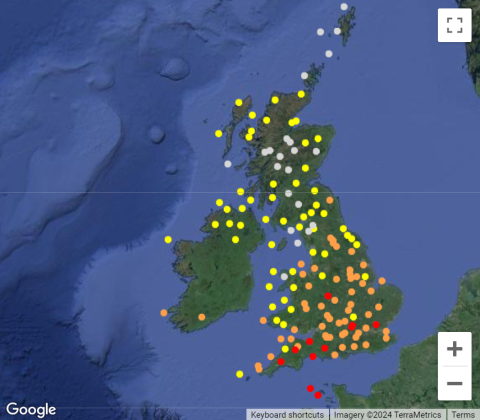Access the forecast HERE
How does the SCOPS Nematodirus Forecast work?
The forecast predicts the hatch date for nematodirus based on temperature data from 140 weather stations throughout the UK and should be used in combination with your grazing history (more below) to assess the risk of nematodirus infection in your lambs. To use the forecast:-
- Zoom in on the map to locate the station(s) closest to your holding. Use knowledge of your farm and the surrounding area to choose the weather station that is most relevant to you. In most cases this will be the nearest station but if, for example, there is a large difference in the height above sea level between your holding and the nearest weather station, then look to see if another station further away may be more representative. (If you click on a station it will give the height above sea level). Alternatively take a view across a combination of stations in your area.
- Click on the station(s). Each station has more detailed information on the current risk level, guidance on what to do next, and information on when the forecast was last updated.
- Carry out a risk assessment and take action if needed. Click here for more on how to assess risk and what action to take.
- Consider additional information to the forecast map.
- The map predicts hatch date on temperature data, but the risk will vary from farm-to-farm and from field-to-field. When deciding whether or not to act, it is important to assess the risk to each group of lambs based on the history of the field and its aspect and altitude. South-facing fields tend to have an earlier hatch and, as a guide, every 100m increase in altitude will delay hatching by about seven days. So, for example, if the nearest weather station on the map is at 200m above sea level and the farm 100m above sea level, hatching could be around seven days earlier than the forecast.
- You can also click here to see a table capturing data from the map over the previous weeks, so you can see when the dot indicating your nearest weather station changed colour. You will need to know the name of your nearest station to find it in the table, so click on that station on the map above to check the name.
For an overview on the forecast, watch the following video.
Understanding nematodirus
Nematodirosis is a particularly nasty disease in lambs, causing a high number of mortalities and stunting the growth of many others. It is caused by the Nematodirus battus worm, which has a different lifecycle to other sheep worms. Under certain climatic conditions it can strike very quickly, with little or no warning. The main difference in the lifecycle of Nematodirus battus compared with other parasitic worms is that development to infective larvae takes place within the egg and infection passes from one lamb crop to the next year’s crop. Cold weather delays hatching so when we get a sudden change in temperature it can trigger a mass hatch. If this coincides with the time when lambs are starting to take in significant amounts of grass (over about six weeks old), the result can be devastating. Find out more here.


